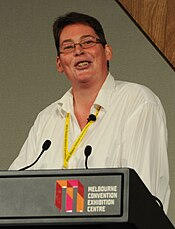...and boy was it not at all what I expected.
I guess I should outline my reasons for attending the convention before I begin, because it turns out that the reasons I enjoyed it so much weren't really the reasons I went.
Basically, I saw a post by
PZ saying that he was speaking at this
atheist convention in Melbourne, and Richard Dawkins was the headline speaker. Both Dawkins and PZ are people whose writing I enjoy and admire, and Melbourne's awfully close, so I knew that I just
had to go. Plus,
Dawkins' books are required reading for any geneticist (arguably any biologist), so I really wanted to hear him speak.
The rest of the line-up at the convention was made up of a lot of people I hadn't heard of (or had vaguely heard of but I wasn't familiar with). And, to be honest, I was expecting most of them to be dull. That was totally unfair, but I was basing my assumption on the fact that most speakers at most events are a bit boring, and only occasionally are they punctuated by good, engaging speakers.
Boy, was I ever wrong!
I'll start with the Friday evening drinks... I rocked on up to the Melbourne Convention and Exhibition Centre having walked for half an hour in my heels because I'd gotten off at the wrong tram stop and fluffed around trying to figure out where the heck I was. I was battling blisters for the rest of the evening, but I suppose that'll teach me for wearing silly shoes... Wait, what am I saying? I love those shoes. Anyway.
After nervously downing a glass of wine while trying to spot approachable strangers to make friends with, I spotted PZ through the crowd, surrounded by a bunch of fanboys. Given that he looked totally surrounded by doods, I decided not to make contact at that particular moment. Looking at the crowd was interesting, I think I had expected more old people. And more unattractive people. I started chatting to two (intimidatingly beautiful) medical students from Brisbane, who were both there with the aim of persuading Richard Dawkins to leave his wife Lalla and shack up with them instead. Heh.
Soon enough we were herded into the auditorium to kick off events. The MCs of the convention introduced themselves, Stuart Bechman and Kylie Sturgess. Stuart is the president of Atheist Alliance International, and is from LA. Kylie is an Australian skeptic and
blogger. They were great MCs, with excellent senses of humour and very different backgrounds.
The first speaker was
Sue-Ann Post, an Australian comedian. She was great - her background as a lesbian ex-Mormon definitely gives her a shitload of material for routines.
(Image from Wikipedia)
Second speaker: Mark Tier. Totally forgettable (I'm sorry! I truly have forgotten his talk - not trying to be rude!). OK, I just looked him up on the convention website again, and now I remember, he was talking about the high level of religiosity in the Philippines (he's an Australian who now lives in in the Philippines). I also remember wondering what the fuck his point was. I still have no idea.
Third speaker: Catherine Deveny, another Australian comedian. Her topic was "
God is Bullshit. That's the Good News". She told her story of 'conversion' (I don't like that word, but oh well) from catholicism to atheism, and like Sue-Ann, she was very funny.
Well that was it for the first night, and while the comedy had been great, I was still wondering whether attending the convention had actually been a colossal waste of money.
Saturday abolished all those worries pretty quickly, but that will have to wait for another post...
















